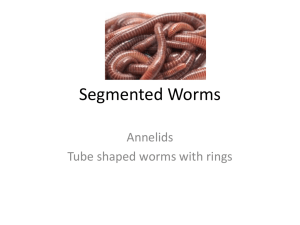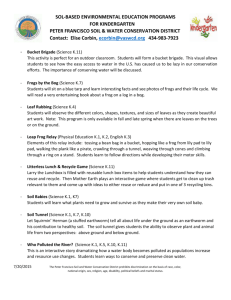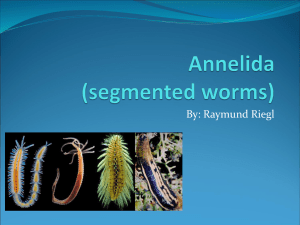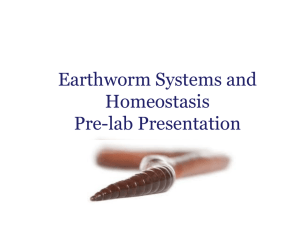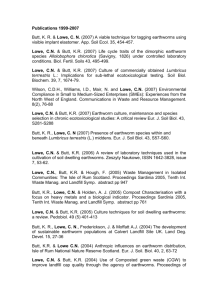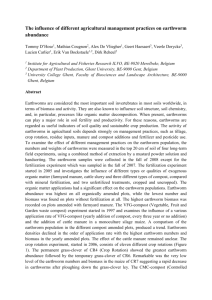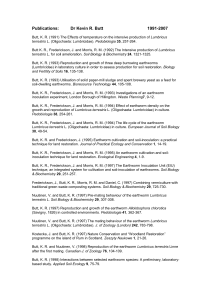Supplementary material List 1: Papers used in data amalgamation
advertisement
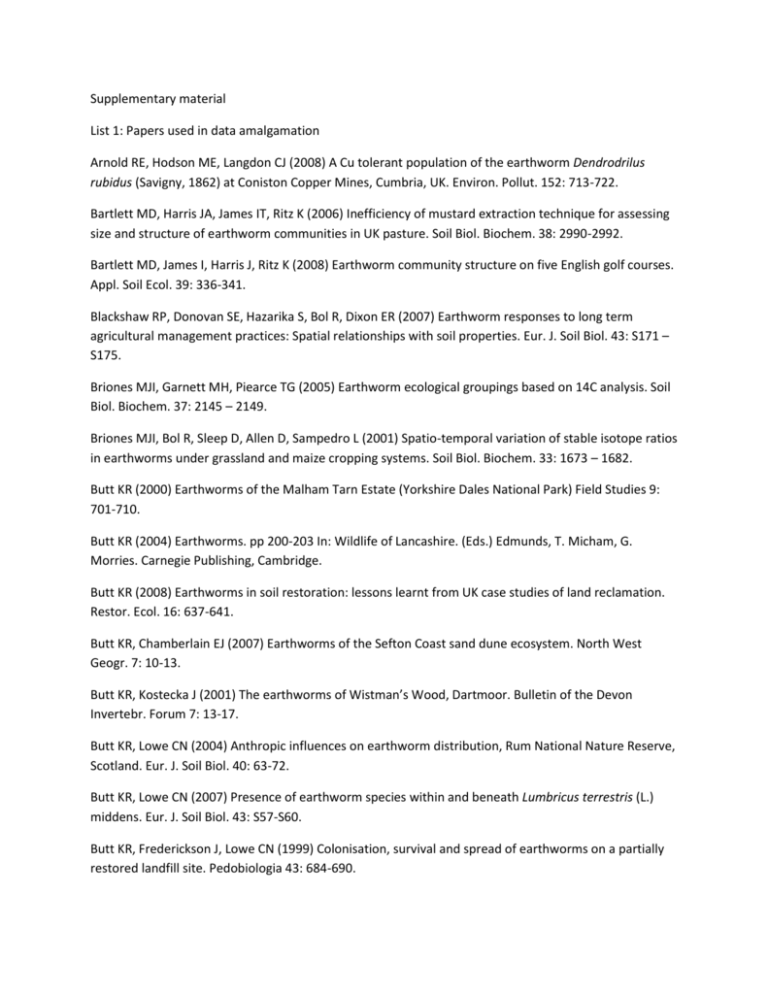
Supplementary material List 1: Papers used in data amalgamation Arnold RE, Hodson ME, Langdon CJ (2008) A Cu tolerant population of the earthworm Dendrodrilus rubidus (Savigny, 1862) at Coniston Copper Mines, Cumbria, UK. Environ. Pollut. 152: 713-722. Bartlett MD, Harris JA, James IT, Ritz K (2006) Inefficiency of mustard extraction technique for assessing size and structure of earthworm communities in UK pasture. Soil Biol. Biochem. 38: 2990-2992. Bartlett MD, James I, Harris J, Ritz K (2008) Earthworm community structure on five English golf courses. Appl. Soil Ecol. 39: 336-341. Blackshaw RP, Donovan SE, Hazarika S, Bol R, Dixon ER (2007) Earthworm responses to long term agricultural management practices: Spatial relationships with soil properties. Eur. J. Soil Biol. 43: S171 – S175. Briones MJI, Garnett MH, Piearce TG (2005) Earthworm ecological groupings based on 14C analysis. Soil Biol. Biochem. 37: 2145 – 2149. Briones MJI, Bol R, Sleep D, Allen D, Sampedro L (2001) Spatio-temporal variation of stable isotope ratios in earthworms under grassland and maize cropping systems. Soil Biol. Biochem. 33: 1673 – 1682. Butt KR (2000) Earthworms of the Malham Tarn Estate (Yorkshire Dales National Park) Field Studies 9: 701-710. Butt KR (2004) Earthworms. pp 200-203 In: Wildlife of Lancashire. (Eds.) Edmunds, T. Micham, G. Morries. Carnegie Publishing, Cambridge. Butt KR (2008) Earthworms in soil restoration: lessons learnt from UK case studies of land reclamation. Restor. Ecol. 16: 637-641. Butt KR, Chamberlain EJ (2007) Earthworms of the Sefton Coast sand dune ecosystem. North West Geogr. 7: 10-13. Butt KR, Kostecka J (2001) The earthworms of Wistman’s Wood, Dartmoor. Bulletin of the Devon Invertebr. Forum 7: 13-17. Butt KR, Lowe CN (2004) Anthropic influences on earthworm distribution, Rum National Nature Reserve, Scotland. Eur. J. Soil Biol. 40: 63-72. Butt KR, Lowe CN (2007) Presence of earthworm species within and beneath Lumbricus terrestris (L.) middens. Eur. J. Soil Biol. 43: S57-S60. Butt KR, Frederickson J, Lowe CN (1999) Colonisation, survival and spread of earthworms on a partially restored landfill site. Pedobiologia 43: 684-690. Butt KR, Lowe CN, Walmsley T (2003) Monitoring earthworm communities in translocated grasslands affected by the construction of Runway 2 at Manchester Airport. North West Geogr. 3/2: 1-6. Butt KR, Lowe CN, Walmsley T (2003) Development of earthworms communities in translocated grasslands at Manchester Airport, UK. Pedobiologia 47: 788-791. Butt KR, Lowe CN, Frederickson J, Moffat AJ (2004) The development of sustainable earthworm populations at Calvert Landfill Site UK. Land Degrad. Dev. 15: 27-36. Butt KR, Lowe C.N, Beasley T, Hanson I, Keynes R (2008) Darwin’s earthworms revisited. Eur. J. Soil Biol. 44: 255-259. Curry JP, Byrne D, Schmidt O (2002) Intensive cultivation can drastically reduce earthworm populations in arable land. Eur. J. Soil Biol. 38: 127-130. Curry JP, Doherty P, Purvis G, Schmidt O (2008) Relationships between earthworm populations and management intensity in cattle-grazed pastures in Ireland. Appl. Soil Ecol. 39: 58-64. Davidson D, Grieve I (2006) Relationships between biodiversity and soil structure and function: Evidence from laboratory and field experiments. Appl. Soil Ecol. 33: 176-185. Davidson D, Grieve I (2006) The influence of soil fauna on soil structural attributes under a limed and untreated upland grassland. Land Degrad. Dev. 17: 393–400. Hutcheson JA, Iles DR, Kendall DA (2001) Earthworm populations in conventional and integrated farming systems in the LIFE Project (SW England) in 1990 – 2000. Ann. appl. Biol. 139: 361 – 372. Jones HD, Santoro G, Boag B, Neilson R (2001) The diversity of earthworms in 200 Scottish fields and the possible effect of New Zealand land flatworms (Arthurdendyus triangulatus) on earthworm populations. Ann. appl. Biol. 139: 75–92. Marashi ARA, Scullion J (2003) Earthworm casts form stable aggregates in physically degraded soils. Biol. Fertil. Soils 37: 375-380. Mather, C (2003) Difference in morphometric performance of the New Zealand flatworm Arthurdendyus triangulatus in earthworm species-poor and -rich habitats at Benmore, Scotland. Pedobiologia 47: 371 – 378. Morgan AJ, Turner MP, Morgan JE (2002) Morphological plasticity in metal-sequestering earthworm chloragocytes: Morphometric electron microscopy provides a biomarker of exposure in field populations. Environ. Toxicol. Chem. 21: 610 – 618. Muldowney J, Curry JP, O'Keeffe J, Schmidt O (2003) Relationships between earthworm populations, grassland management and badger densities in County Kilkenny, Ireland: The 7th international symposium on earthworm ecology, Cardiff, Wales, 2002. Pedobiologia 47: 913 – 919. Neilson R, Boag B, Smith M (2000) Earthworm d13C and d15N analyses suggest that putative functional classifications of earthworms are site-specific and may also indicate habitat diversity. Soil Biol. Biochem. 32: 1053-1061. Langdon CJ, Piearce TG, Feldmann J, Semple KT, Meharg AA (2003) Arsenic speciation in the earthworms Lumbricus rubellus and Dendrodrilus rubidus. Environ. Toxicol. Chem. 22: 1302–1308. Römbke R, Van Gestel CAM, Jones SE, Koolhaas JE, Rodrigues JML, Moser T (2004) Ring-testing and fieldvalidation of a terrestrial model ecosystem (TME) – an instrument for testing potentially harmful substances: effects of Carbendazim on earthworms. Ecotoxicology 13: 105-118. Schmidt O (2001) Appraisal of the electrical octet method for estimating earthworm populations in arable land. Ann. appl. Biol. 138: 231–241. Schmidt O (2001) Time-limited soil sorting for long-term monitoring of earthworm populations. Pedobiologia 45: 69–83. Schmidt O, Curry JP (2001) Population dynamics of earthworms (Lumbricidae) and their role in nitrogen turnover in wheat and wheat–clover cropping systems. Pedobiologia 45: 174–187. Schmidt O, Scrimgeour CM (2001) A simple urea leaf-feeding method for the production of 13C and 15N labelled plant material. Plant Soil 229: 197–202. Schmidt O, Curry JP, Hackett RA, Purvis G, Clements RO (2001) Earthworm communities in conventional wheat monocropping and low-input wheat–clover intercropping systems. Ann. Appl. Biol. 138: 377–388. Scullion J, Neale S, Philips L (2007). Earthworm casting and burrowing activity in conventional and organic grass-arable rotations. Eur. J. Soil Biol. 43: 216-221. Sherlock E, Carpenter D (2009) An updated earthworm list for the British Isles and two new ‘exotic’ species to Britain from Kew Gardens. Eur. J. Soil Biol. 45: 431-435. Sims RW, Gerard BM (1985) A synopsis of the British fauna: earthworms. Published for the Linnean Society of London and the Estuarine and Brackish-Water Sciences Association by EJ Brill and Dr W Backhuys, London. Sims RW, Gerard BM (1999) Earthworms. Synopses of the British Fauna (New Series). Linnean Society of London, The Estuarine and Coastal Sciences Association and Field Studies Council, London. Spurgeon DJ, Hopkin SP (1999) Tolerance to Zinc in populations of the earthworm Lumbricus rubellus from uncontaminated and metal-contaminated ecosystems. Arch. Environ. Con. Tox. 37: 332-337. Spurgeon DJ, Hopkin SP (1999) Seasonal variation in the abundance, biomass and biodiversity of earthworms in soils contaminated with metal emissions from a primary smelting works. J. Appl. Ecol. 36: 173–183. Watts M, Button M, Brewer TS, Jenkin GWT, Harrington CF (2008) Quantitative arsenic speciation in two species of earthworms from a former mine site. J. Environ. Monitor. 10: 753-759.


